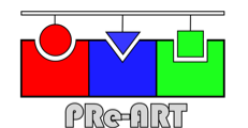Project leader
Anna Hine
PRe-ART project team
Anupama Chembath (centre, postdoc)
Mohammed Ashraf (right, senior technician)
Ben Wagstaffe (left, PhD student)
Introduction
The Hine lab’s principal expertise is in high-throughput gene/protein library generation. We have invented both ‘MAX’ and ‘ProxiMAX’ and randomization technologies. Each is a defined saturation mutagenesis platform that delivers precision control of both identity and relative ratio of amino acids at specified locations within a protein library. Each process is non-degenerate, meaning that encoding DNA libraries are as small as is physically possible. ‘MAX’ randomization targets codons at separated locations within a gene and is particularly applicable to α-helical proteins, whilst ‘ProxiMAX’ is designed to saturate multiple contiguous codons as required in antibody engineering and is the technology that lies behind Isogenica’s Colibra™ offering.
Since no constraints are imposed by the genetic code, both technologies can eliminate unwanted amino acids such as cysteine and methionine from libraries or encode desired subsets of amino acids with ease. We also have expertise in analyzing protein-ligand interactions and particularly relevant to the PRe-ART project, in collaborating with physical scientists, including chemists, chemical engineers, materials scientists, physicists and mathematicians. Such collaborative projects include development of photonic biosensors, delivery of active proteins to the cytoplasm of cells, protein-based purification of plasmid DNA and mathematical prediction of protein-DNA interactions.
Role of Aston within the PRe-ART Consortium
The principal role of Aston within this project is the creation of the DNA libraries. In collaboration with the Plückthun (UZH) and Höcker (UBT) labs, and informed by screening (UZH), structural (UZH) and modelling (UBT) data, we also contribute to the design of those libraries during iterative cycles.
Selected References – ‘MAX’ and ‘ProxiMAX’ randomization
Ferreira-Amaral, M.M., Frigotto, L. and Hine, A.V. (2017). Beyond the natural proteome: nondegenerate saturation mutagenesis – methodologies and advantages. Meth. Enyzmol. 585, 111-133. Link to article.
Frigotto L., Smith, M.E., Brankin, C., Sedani, A., Cooper, S.E., Kanwar, N., Evans, D., Svobodova, S., Baar, C., Glanville, J, Ullman, C.G. and Hine, A.V. (2015). Codon-precise, synthetic, antibody fragment libraries built using automated hexamer codon additions and validated through Next Generation Sequencing. Antibodies 4, 88-102. Link to article.
Ashraf, M., Frigotto, L., Smith, M.E., Patel, S., Hughes, M.D., Poole, A.J., Hebaishi, H.R.M., Ullman, C.G. and Hine, A.V. (2013). ProxiMAX randomisation: a new technology for non-degenerate saturation mutagenesis of contiguous codons. Biochem. Soc. Trans. 41, 1189-1194. Link to article.
Ashraf, M., Hughes, M.D. and Hine, A.V. (2011-13). Oligonucleotide library encoding randomised peptides. Patents (granted) US 8357638 B2, EP 2236612 and EP 1907548.
Hughes, M.D., Zhang, Z.-R., Sutherland, A.J., Santos, A.F. and Hine, A.V. (2005). Discovery of active proteins directly from combinatorial randomized protein libraries without display, purification or sequencing: identification of novel zinc finger proteins. Nucleic Acids Res. 33, e32, 1-8. Link to article.
Hughes, M.D., Nagel, D.A., Santos, A.F., Sutherland, A.J. and Hine, A.V. (2003). Removing the redundancy from randomised gene libraries. J. Mol. Biol., 331, 967-972. Link to article.
– Interdisciplinary collaborations
Allsop, T., Mou, C., Neal, R., Mariani, S. Nagel, D., Tombelli, S., Poole, A., Kalli, K., Hine, A., Webb, D.J., Culverhouse, P., Mascini, M., Minunni, M. and Bennion, I. (2017). Real-time kinetic binding studies at attomolar concentrations in solution phase using a single-stage opto-biosensing platform based upon infrared surface plasmons. Optics Express 25, 39-58. Link to article.
Chimonides, G. F., Behrendt, J. M., Chundoo, E., Bland, C., Hine, A. V., Devitt, A., Nagel, D. A. and Sutherland, A. J. (2014). Cellular uptake of ribonuclease A functionalised core–shell silica microspheres. J Mater Chem B, 2, 7307-7315 (Front cover). Link to article.
Nagel, D., Behrendt, J.M., Chimonides, G.F., Torr, E E., Devitt, A., Sutherland, A.J. and Hine A.V. (2014). Polymeric Microspheres as Protein Transduction Reagents. Mol. Cell Proteomics, 13, 1543-1551 (Front cover). Link to article.
Wang, X., Hine, A.V. and Lowe, D (2012). Signal Processing Issues of High–Dimensional Visual Informatics: A Study in Protein–DNA Binding Patterns. 9th IMA International Conference on Mathematics in Signal Processing, UK.
Barbosa, H.S.C., Hine, AV., Brocchini, S., Slater, N.K.H. and Marcos, J.C. (2010). Dual affinity method for plasmid DNA purification in aqueous two-phase systems. J. Chromatography A, 1217, 1429-1436. Link to article.
Darby, R.A.J., Forde, G.M., Slater, N.K.H. and Hine, A.V. (2007). Affinity purification of plasmid DNA directly from crude bacterial cell lysates. Biotechnol. Bioeng. 98, 1103-1108. Link to article.
Chen X.F., Zhang L., Zhou, K.M., Davies, E., Sugden K., Bennion I., Hughes M.D. and Hine, AV. (2007). Real-time detection of DNA interactions with long-period fiber-grating-based biosensor. Optics Lett. 32, 2541-2543. Link to article.
